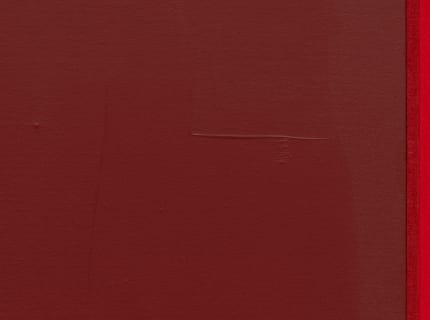At the Guggenheim museum there is a small gallery, the first space open to visitors who begin at the ground floor, to climb the slow upward spiral. It is a unique space because if one continues on the upward trajectory, one eventually arrives at a large window in which all the works in the lower gallery become visible from a distinctly different angle. If you are visiting Jennie C. Jones’s Dynamics exhibition, you should look at the work in that gallery from both vantages. At the higher point, the subtle fissures, ridges, and folds of color that Jennie C. Jones embeds in her paintings become more apparent. There are shy and subtle, a vivacious child hidden in the folds of her mother’s dress and peeking out now and again to see whether you are paying attention.
My noticing these furtive aspects of Jennie C. Jones’s work is strongly inflected by my experience as a teenager seeing Barnett Newman’s paintings at the Museum of Modern Art. I remember being transfixed by the rigorous demarcation of space, one field of color separated from another by a resolute line cleanly and affirmatively lain down, a rebuke to the chaos I experienced growing up in a home with two adults who did not like each other and whose animus bled everywhere it could bleed. I was drawn to Newman’s ability to construct order out of all the disorder that is all around me, tilling one plot of land until the rows were perfectly straight all the way to the horizon. And in a few paintings, for example “Onement I” (1948), there would be a line that had a little wobble to it, was uneven, showed a bit of the underpainting, wavering a little on its path. Seeing these pieces felt like someone who knew more than I did admitting to me that there would always be a little unsettledness in the world, that even my own innate instability would roil my consciousness and make me feel unmoored from time to time. But I love the forceful assertion of control. In discussing his own paintings, he said in the pages of Artnews in 1966: “I wanted to hold the emotion, not waste it in picturesque ecstasies. The cry, the unanswerable cry is world without end. But a painting has to hold it, world without end, in its limits.” But what if instead, where you are from the sound you hear is a plea to be let out?

